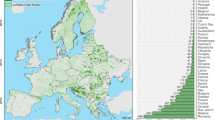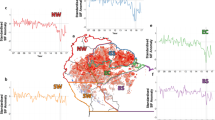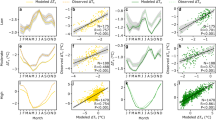Abstract
The seasonality of sunlight and rainfall regulates net primary production in tropical forests1. Previous studies have suggested that light is more limiting than water for tropical forest productivity2, consistent with greening of Amazon forests during the dry season in satellite data3,4,5,6,7. We evaluated four potential mechanisms for the seasonal green-up phenomenon, including increases in leaf area5,6,7 or leaf reflectance3,4,6, using a sophisticated radiative transfer model8 and independent satellite observations from lidar and optical sensors. Here we show that the apparent green up of Amazon forests in optical remote sensing data resulted from seasonal changes in near-infrared reflectance, an artefact of variations in sun-sensor geometry. Correcting this bidirectional reflectance effect eliminated seasonal changes in surface reflectance, consistent with independent lidar observations and model simulations with unchanging canopy properties. The stability of Amazon forest structure and reflectance over seasonal timescales challenges the paradigm of light-limited net primary production in Amazon forests and enhanced forest growth during drought conditions. Correcting optical remote sensing data for artefacts of sun-sensor geometry is essential to isolate the response of global vegetation to seasonal and interannual climate variability.
This is a preview of subscription content, access via your institution
Access options
Subscribe to this journal
Receive 51 print issues and online access
$199.00 per year
only $3.90 per issue
Buy this article
- Purchase on Springer Link
- Instant access to full article PDF
Prices may be subject to local taxes which are calculated during checkout



Similar content being viewed by others
References
Saleska, S. R. et al. Carbon in Amazon forests: unexpected seasonal fluxes and disturbance-induced losses. Science 302, 1554–1557 (2003)
Nemani, R. R. et al. Climate-driven increases in global terrestrial net primary production from 1982 to 1999. Science 300, 1560–1563 (2003)
Huete, A. R. et al. Amazon rainforests green-up with sunlight in dry season. Geophys. Res. Lett. 33, L06405 (2006)
Brando, P. M. et al. Seasonal and interannual variability of climate and vegetation indices across the Amazon. Proc. Natl Acad. Sci. USA 107, 14685–14690 (2010)
Myneni, R. B. et al. Large seasonal swings in leaf area of Amazon rainforests. Proc. Natl Acad. Sci. USA 104, 4820–4823 (2007)
Doughty, C. E. & Goulden, M. L. Seasonal patterns of tropical forest leaf area index and CO2 exchange. J. Geophys. Res. 113, G00B06 (2008)
Samanta, A. et al. Seasonal changes in leaf area of Amazon forests from leaf flushing and abscission. J. Geophys. Res. 117, G01015 (2012)
North, P. R. J., Rosette, J. A. B., Suarez, J. C. & Los, S. O. A Monte Carlo radiative transfer model of satellite waveform LiDAR. Int. J. Remote Sens. 31, 1343–1358 (2010)
Davidson, E. A. et al. The Amazon basin in transition. Nature 481, 321–328 (2012)
Pan, Y. et al. A large and persistent carbon sink in the world’s forests. Science 333, 988–993 (2011)
Chevallier, F. et al. Global CO2 fluxes inferred from surface air-sample measurements and from TCCON retrievals of the CO2 total column. Geophys. Res. Lett. 38, L24810 (2011)
Gatti, L. V. et al. Vertical profiles of CO2 above eastern Amazonia suggest a net carbon flux to the atmosphere and balanced biosphere between 2000 and 2009. Tellus B Chem. Phys. Meterol. 62, 581–594 (2010)
van der Werf, G. R. et al. C02 emissions from deforestation. Nature Geosci. 2, 737–738 (2009)
Phillips, O. L. et al. Drought sensitivity of the Amazon rainforest. Science 323, 1344–1347 (2009)
Le Quére, C. et al. Trends in the sources and sinks of carbon dioxide. Nature Geosci. 2, 831–836 (2009)
Lewis, S. L., Brando, P. M., Phillips, O. L., van der Heijden, G. M. F. & Nepstad, D. The 2010 Amazon drought. Science 331, 554 (2011)
Saleska, S. R., Didan, K., Huete, A. R. & da Rocha, H. R. Amazon forests green-up during 2005 drought. Science 318, 612–612 (2007)
Zelazowski, P., Malhi, Y., Huntingford, C., Sitch, S. & Fisher, J. B. Changes in the potential distribution of humid tropical forests on a warmer planet. Phil. Trans. Royal Soc. A 369, 137–160 (2011)
Kim, Y. et al. Seasonal carbon dynamics and water fluxes in an Amazon rainforest. Glob. Change Biol. 18, 1322–1334 (2012)
Toomey, M., Roberts, D. A. & Nelson, B. The influence of epiphylls on remote sensing of humid forests. Remote Sens. Environ. 113, 1787–1798 (2009)
Nepstad, D. C. et al. The role of deep roots in the hydrological and carbon cycles of Amazonian forests and pastures. Nature 372, 666–669 (1994)
Galvão, L. S. et al. On intra-annual EVI variability in the dry season of tropical forest: a case study with MODIS and hyperspectral data. Remote Sens. Environ. 115, 2350–2359 (2011)
Carabajal, C. C. & Harding, D. J. SRTM C-Band and ICESat laser altimetry elevation comparisons as a function of tree cover and relief. Photogramm. Eng. Remote Sensing 72, 287–298 (2006)
Schutz, B. E., Zwally, H. J., Shuman, C. A., Hancock, D. & DiMarzio, J. P. Overview of the ICESat mission. Geophys. Res. Lett. 32, L21S01 (2005)
Bréon, F.-M., Maignan, F., Leroy, M. & Grant, I. Analysis of hot spot directional signatures measured from space. J. Geophys. Res. 107 http://dx.doi.org/10.1029/2001JD001094 (2002)
Rahman, A. F., Sims, D. A., Cordova, V. D. & El-Masri, B. Z. Potential of MODIS EVI and surface temperature for directly estimating per-pixel ecosystem C fluxes. Geophys. Res. Lett. 32, L19404 (2005)
Joiner, J., Yoshida, Y., Vasilkov, A. P., Corp, L. A. & Middleton, E. M. First observations of global and seasonal terrestrial chlorophyll fluorescence from space. Biogeosciences 8, 637–651 (2011)
Hilker, T. et al. Inferring terrestrial photosynthetic light use efficiency of temperate ecosystems from space. J. Geophys. Res. 116, G03014 (2011)
Nepstad, D. C., Tohver, I. M., Ray, D., Moutinho, P. & Cardinot, G. Mortality of large trees and lianas following experimental drought in an Amazon forest. Ecology 88, 2259–2269 (2007)
Jiang, Z., Huete, A. R., Didan, K. & Miura, T. Development of a two-band enhanced vegetation index without a blue band. Remote Sens. Environ. 112, 3833–3845 (2008)
Palace, M., Keller, M., Asner, G. P., Hagen, S. & Braswell, B. Amazon forest structure from IKONOS satellite data and the automated characterization of forest canopy properties. Biotropica 40, 141–150 (2008)
Asner, G. P. et al. Estimating canopy structure in an Amazon forest from Laser Range Finder and IKONOS satellite observations. Biotropica 34, 483–492 (2002)
Hunter, M. O., Keller, M., Vitoria, D. & Morton, D. C. Tree height and tropical forest biomass estimation. Biogeosciences Discuss. 10, 10491–10529 (2013)
King, D. A. Allometry of saplings and understory trees of a Panamanian forest. Funct. Ecol. 4, 27–32 (1990)
Osunkoya, O. O. et al. Comparative height crown allometry and mechanical design in 22 tree species of Kuala Belalong rainforest, Brunei, Borneo. Am. J. Bot. 94, 1951–1962 (2007)
Keller, M., Palace, M. & Hurtt, G. C. Biomass estimation in the Tapajos National Forest, Brazil: examination of sampling and allometric uncertainties. For. Ecol. Manage. 154, 371–382 (2001)
Feldpausch, T. R. et al. Height-diameter allometry of tropical forest trees. Biogeosciences 8, 1081–1106 (2011)
Saatchi, S. S. et al. Benchmark map of forest carbon stocks in tropical regions across three continents. Proc. Natl Acad. Sci. USA. 108, 9899–9904 (2011)
Baccini, A. et al. Estimated carbon dioxide emissions from tropical deforestation improved by carbon-density maps. Nature Clim. Change 2, 182–185 (2012)
North, P. R. J. Three-dimensional forest light interaction model using a Monte Carlo method. IEEE Trans. Geosci. Rem. Sens. 34, 946–956 (1996)
Huete, A. R., Ferreira, L. & Miura, T. LBA-ECO LC-19 Field Measurements 2002: Biophysical & Soil Parameters. http://www.lbaeco.org (2008)
Hofton, M. A., Minster, J. B. & Blair, J. B. Decomposition of laser altimeter waveforms. IEEE Trans. Geosci. Rem. Sens. 38, 1989–1996 (2000)
Harding, D. J. & Carabajal, C. C. ICESat waveform measurements of within-footprint topographic relief and vegetation vertical structure. Geophys. Res. Lett. 32, L21S10 (2005)
Morton, D. C. et al. Mapping canopy damage from understory fires in Amazon forests using annual time series of Landsat and MODIS data. Remote Sens. Environ. 115, 1706–1720 (2011)
Morton, D. C., Le Page, Y., DeFries, R., Collatz, G. J. & Hurtt, G. C. Understorey fire frequency and the fate of burned forests in southern Amazonia. Phil. Trans. R. Soc. Lond. B 368, (2013)
Hilker, T. et al. Remote sensing of tropical ecosystems: atmospheric correction and cloud masking matter. Remote Sens. Environ. 127, 370–384 (2012)
Vermote, E. F., Justice, C. & Breon, F.-M. Towards a generalized approach for correction of the BRDF effect in MODIS directional reflectance. IEEE Trans. Geosci. Rem. Sens. 47, 898–908 (2009)
Schaaf, C. B. et al. First operational BRDF, albedo nadir reflectance products from MODIS. Remote Sens. Environ. 83, 135–148 (2002)
Vermote, E. F. & Kotchenova, S. Atmospheric correction for the monitoring of land surfaces. J. Geophys. Res. D Atmospheres 113, D23S90 (2008)
Acknowledgements
Funding for this research was provided by NASA, the NASA Postdoctoral Program and the NERC National Centre for Earth Observation. We thank G. P. Asner for providing Amazon leaf reflectance data.
Author information
Authors and Affiliations
Contributions
D.C.M. and J.N. designed the experiment. D.C.M., J.N. and E.F.V. analysed MODIS data. D.C.M., C.C.C., B.D.C. and D.J.H. analysed ICESat data. M.P. developed the synthetic forest model. D.C.M., J.N., J.R., B.D.C. and P.R.J.N. contributed to radiative transfer model simulations. D.C.M. wrote the manuscript, and all authors contributed material to the final version.
Corresponding author
Ethics declarations
Competing interests
The authors declare no competing financial interests.
Additional information
Data from NASA’s ICESat, Terra, and Aqua satellites are archived at http://www.nsidc.org and http://lpdaac.usgs.gov.
Extended data figures and tables
Extended Data Figure 1 Synthetic Amazon forest developed from field measurements of forest structure and reflectance properties.
a, Oblique view of the 1 km × 1 km synthetic forest. b, Reflectance (ρ) and transmittance (τ) properties of Amazon leaves (G. P. Asner, unpublished data) and litter41 at MODIS (red, 620–670 nm; NIR, 841–876 nm) and ICESat (NIR, 1064 nm) wavelengths. c, d, Parameter values for lidar and optical radiative transfer simulations. Field measurements of ρLitter differ slightly at optical (860 nm) and lidar (1064 nm) NIR wavelengths (see b). June conditions were used to estimate early dry season (baseline) lidar and optical remote sensing metrics with FLIGHT. e–g, Height-diameter relationships (e) and crown depth (f) and width (g) estimates for small trees (< 20-cm diameter at breast height) were derived from allometric relationships for larger trees (>20-cm diameter at breast height) using regression with a power-law function.
Extended Data Figure 2 FLIGHT model simulations of GLAS lidar waveforms.
a, Distribution of modelled waveform centroid relative height (WCRH) for 100 simulated GLAS lidar footprints located at the centre of each 100 × 100 m grid box of the synthetic Amazon forest. b, Nadir view of the waveform selected for FLIGHT model simulations (blue outline). The dashed vertical line in a indicates the June WCRH (0.519) for the footprint location in b.
Extended Data Figure 3 Seasonal variability in MODIS surface reflectance, vegetation indices, and sun-sensor geometry.
Seasonal distributions of NDVI, EVI and near-infrared (NIR) reflectance for uncorrected (a–c) and corrected (e–g) MODIS 1 km data from 2003–08, in which corrected MODIS data have been normalized to a consistent sun-sensor geometry. Lines denote the median (black) and upper and lower quartile median values (grey) for uncorrected and corrected MODIS observations. The decrease in solar zenith angle between day of year 150 and 300 (d) increases the frequency of observations near the principal plane (h, ϕ = 0°, ϕ = 180°).
Extended Data Figure 4 Impact of changing MODIS sun-sensor geometry on NDVI.
a–c, Seasonal changes in sun-sensor geometry decrease MODIS NDVI over Amazon forest between June and October. As for EVI (see Fig. 1), modelled directional anisotropy of the MODIS NDVI over southern Amazon forests is stronger in June (a) than October (b), but the realized bidirectional reflectance effect in MODIS observations is greater in October (b, c) when the Terra and Aqua MODIS instruments sample in the principal plane (ϕ = 0°, ϕ = 180°). For NDVI, the hot spot effect near θv = 20° increases red reflectance, thereby lowering NDVI values at these viewing angles. d, Seasonal profile of red reflectance for uncorrected (grey) and corrected (black) MODIS 1 km data in southern Amazonia. Values indicate the upper quartile median monthly red reflectance from all Terra and Aqua MODIS observations in 2003–08 (n = 197,651). e, Per-pixel changes in uncorrected (grey) and corrected (black) MODIS NDVI between October and June for all forested areas in southern Amazonia. Small seasonal decreases in MODIS NDVI data were eliminated after normalizing the sun-sensor geometry during the June to October dry season.
Extended Data Figure 5 Spatial pattern of seasonal changes in GLAS lidar metrics.
a–f, June, October, and difference maps (October minus June) of WCRH (a–c) and 1064 nm apparent reflectance (d–f) for 0.25° grid cells in southern Amazonia with ≥ 10 pairs of June and October GLAS footprints. White cells indicate non-forest areas or grid cells with <10 GLAS lidar footprints in one or both months.
Extended Data Figure 6 Correlation between GLAS lidar WCRH and mean annual precipitation.
Values indicate mean June WCRH and mean annual precipitation (September to August, 1997–2009) from the tropical rainfall measurement mission (TRMM) 3B43v6 product for 0.25° cells with ≥ 10 GLAS footprint pairs (n = 728, see Extended Data Fig. 5).
Extended Data Figure 7 Maps of seasonal amplitude in uncorrected and corrected MODIS EVI data.
a, Seasonal amplitude in uncorrected MODIS EVI data (October minus June) for two 10° × 10° spatial tiles in southern Amazonia (H11V09, H11V10). b, Seasonal amplitude in corrected EVI data (October minus June), using a single BRDF inversion model to normalize changes in sun-sensor geometry for all Amazon forest pixels per tile, per month. Instead of modelling BRDF on a per-pixel basis (see Fig. 3, Extended Data Figs 3, 4 and 8), this map reflects the reduction in the seasonal amplitude of EVI using generic BRDF models derived from all cloud-free MODIS data per tile, per month. c, The difference in the seasonal amplitude of MODIS EVI (uncorrected minus corrected) is positive, highlighting how changes in sun-sensor geometry generate the apparent green up phenomenon. White regions indicate non-forest cover types.
Extended Data Figure 8 Interannual variability in MODIS EVI for southern Amazon forests in 2003–08.
Values indicate the upper quartile median monthly EVI for uncorrected (grey) and corrected (black) MODIS data. Normalization of sun-sensor geometry reduced both seasonal and interannual variability in MODIS EVI over southern Amazon forests.
Extended Data Figure 9 Contribution of variability in MODIS view geometry to interannual differences in EVI over Amazon forests.
EVI and view zenith angle (θv) data from the MOD13A1 16-day composite product (data access: https://lpdaac.usgs.gov) are shown for spatial tile H11V09 when the Terra MODIS sensor was observing in the principal plane (October, day of year 273–288). The fraction of observations in the backscatter direction (θv > 0°) and mean EVI over forests were strongly correlated, highlighting the importance of sun-sensor geometry for interannual variability in uncorrected MODIS EVI data. The drought year of 2005 had the highest fraction of MODIS observations in the backscatter direction of any year during 2000–12.
Supplementary information
Supplementary Information
This file contains a Supplementary Discussion describing the impact of changes in MODIS sun-sensor geometry on NDVI and other optical remote sensing data and Supplementary References. (PDF 135 kb)
Rights and permissions
About this article
Cite this article
Morton, D., Nagol, J., Carabajal, C. et al. Amazon forests maintain consistent canopy structure and greenness during the dry season. Nature 506, 221–224 (2014). https://doi.org/10.1038/nature13006
Received:
Accepted:
Published:
Issue Date:
DOI: https://doi.org/10.1038/nature13006
This article is cited by
-
Widespread and complex drought effects on vegetation physiology inferred from space
Nature Communications (2023)
-
Structural complexity biases vegetation greenness measures
Nature Ecology & Evolution (2023)
-
Optical vegetation indices for monitoring terrestrial ecosystems globally
Nature Reviews Earth & Environment (2022)
-
Forest fragmentation impacts the seasonality of Amazonian evergreen canopies
Nature Communications (2022)
-
Environmental dynamics of the Juruá watershed in the Amazon
Environment, Development and Sustainability (2021)
Comments
By submitting a comment you agree to abide by our Terms and Community Guidelines. If you find something abusive or that does not comply with our terms or guidelines please flag it as inappropriate.



